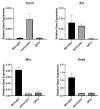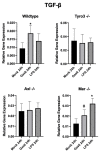Gas6 Induces Myelination through Anti-Inflammatory IL-10 and TGF-β Upregulation in White Matter and Glia
- PMID: 32722558
- PMCID: PMC7465828
- DOI: 10.3390/cells9081779
Gas6 Induces Myelination through Anti-Inflammatory IL-10 and TGF-β Upregulation in White Matter and Glia
Abstract
The Gas6-TAM (Tyro3, Axl, Mer) ligand-receptor system is believed to promote central nervous system (CNS) (re)myelination and glial cell development. An additional important function of Gas6-TAM signalling appears to be the regulation of immunity and inflammation, which remains to be fully elucidated in the CNS. Here, we characterised the expression of TAM receptors and ligands in individual CNS glial cell types, observing high expression of Gas6 and the TAM receptors, Mer and Axl, in microglia, and high expression of Tyro3 in astrocytes. We also investigated the effect of Gas6 on the inflammatory cytokine response in the optic nerve and in mixed glial cell cultures from wildtype and single TAM receptor knockout mice. In wildtype and Mer-deficient cultures, Gas6 significantly stimulated the expression of the anti-inflammatory/pro-repair cytokines interleukin 10 (IL-10) and transforming growth factor β (TGF-β), whereas this effect was absent in either Tyro3 or Axl knockout cultures. Furthermore, Gas6 caused upregulation of myelin basic protein (MBP) expression in optic nerves, which was blocked by a neutralising antibody against IL-10. In conclusion, our data show that microglia are both a major source of Gas6 as well as an effector of Gas6 action in the CNS through the upregulation of anti-inflammatory and pro-repair mediators. Furthermore, the presence of both Axl and Tyro3 receptors appears to be necessary for these effects of Gas6. In addition, IL-10, alongside suppressing inflammation and immunity, mediates the pro-myelinating mechanism of Gas6 action in the optic nerve. Therefore, Gas6 may present an attractive target for novel therapeutic interventions for demyelinating as well as neuroinflammatory disorders of the CNS.
Keywords: Gas6; IL-10; TAM receptor; TGF-β; astrocytes; microglia; myelination; optic nerve; vitamin K; white matter.
Conflict of interest statement
The authors declare no conflict of interest.
Figures






References
Publication types
MeSH terms
Substances
LinkOut - more resources
Full Text Sources
Research Materials
Miscellaneous

